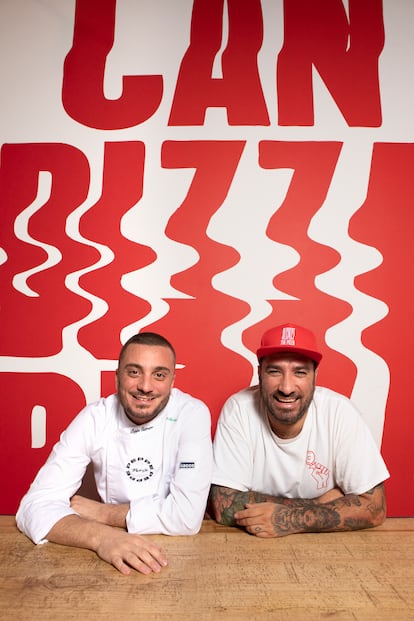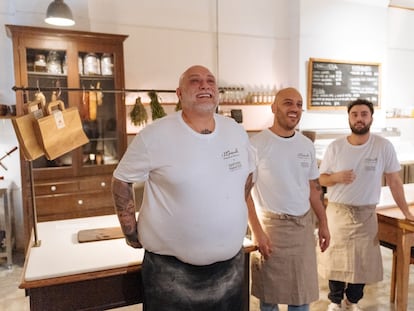Naples and Rome: Two ways of understanding pizza
Peppe Cutraro and Lolo Zozza, both specialists in the famous Italian dish, discuss why it is one of the world’s favorite meals

“Did he say pineapple? Really? Again? No, no, no...”
Voted best pizza maker in Europe in 2021 and 2022, Naples native Peppe Cutraro can’t believe what Lolo Zozza, Madrid Fusión’s top pizza chef in Spain, has just come out with. “Sure, and look, when I’m hungover, I order Domino’s and it’s wonderful,” insists Lolo Zozza, 33, the Roman at the helm of Can Pizza, a chain with 10 restaurants split between Barcelona, Madrid and Ibiza.
The man behind the famous Jerry Tomato pizza, Zozza has invited 26-year-old Peppe Cutraro to bring his creations from Naples to two Can Pizza restaurants in Madrid and Barcelona. In the menu, each chef offers two pizzas. Cutraro’s pizzas depart from the standard Neapolitan pizza by adding ingredients such as taggiasca olives and fig jam. Zozza’s pizzas, meanwhile, are riskier versions of the standard Roman variety, and feature guanciale cured meat and his prized tomato concoction.
“This is what I’ve come for? This is a wind up,” says a disgruntled Peppe Cutraro, who runs a restaurant in Paris called Peppe’s which attracts pizza fans from across the globe. The two have been discussing dough, tomato pastes and mozzarella for almost an hour at the new Can Pizza on Serrano Street in Madrid and have agreed on practically everything. But now the dreaded subject of pineapple has reared its head. “I don’t understand why people get like that when I say I don’t mind pineapple on pizza. I actually like it. When this guy saw it yesterday at our place in Barcelona, he almost got up and went back to Paris,” says Zozza.

The two started working in kitchens when they were just 14 years old. One ended up making pizza. The other started with it. “In Naples it is common to start making pizzas at a very young age, it is a way to earn money for the family,” says Cutraro. Zozza, for his part, worked in kitchens in his native Rome and London and fell in love with pizza thanks to the master Francesco Etzi. As soon as he landed in Barcelona, he met the Colombo brothers (from the Italian restaurant Xemei) and they started Can Pizza.
“We’ve been at this for long enough to see how this trade has evolved,” says Zozza. “The pizza man used to be that man who was in a corner and who only the children noticed. Now there is more recognition, and the fact that there are international competitions, rankings and so on makes the profession more sophisticated and the average quality rises. Now you can eat good pizza anywhere. It is very noticeable in Barcelona, where you can eat any type of quality pizza. Although Barcelona, for me, has always been another Italian city.” Zozza also says that the logical and healthy rejection felt by the new generations to work 70 hours a week in hellish shifts has helped to rationalize the trade. “You understand its red lines and you end up applying them,” he says. “Now you can be a pizza chef and have friends,” Cutraro jokes.
There is Roman, Neapolitan, Argentine, New York, Chicago and Detroit pizza. Even Turkish pizza. “I remember that when I was little in Naples there was no Roman pizza, no one even thought of eating something other than Neapolitan pizza,” Cutraro points out about his city, headquarters of a group called Associazione Verace Pizza Napoletana, which ensures purity of the product and grants seals of authenticity to locals and chefs from all over the world. “And in Rome, of course, there was no Neapolitan pizza,” Lolo intervenes.
Beyond the use of ingredients (“never more than four or five,” warns Zozza), the key to the style of each pizzaiolo is the dough. At Can Pizza, for example, they use five flours and fermentation for 72 hours. “Pizza is magical. Everyone likes it and it is in almost all cultures. It’s even coming to China. Some will add more cheese, others will make it thinner, others with pineapple,” says Zozza. “Did you say pineapple? Seriously?” is heard from Cutraro’s side of the table.
Sign up for our weekly newsletter to get more English-language news coverage from EL PAÍS USA Edition
Tu suscripción se está usando en otro dispositivo
¿Quieres añadir otro usuario a tu suscripción?
Si continúas leyendo en este dispositivo, no se podrá leer en el otro.
FlechaTu suscripción se está usando en otro dispositivo y solo puedes acceder a EL PAÍS desde un dispositivo a la vez.
Si quieres compartir tu cuenta, cambia tu suscripción a la modalidad Premium, así podrás añadir otro usuario. Cada uno accederá con su propia cuenta de email, lo que os permitirá personalizar vuestra experiencia en EL PAÍS.
¿Tienes una suscripción de empresa? Accede aquí para contratar más cuentas.
En el caso de no saber quién está usando tu cuenta, te recomendamos cambiar tu contraseña aquí.
Si decides continuar compartiendo tu cuenta, este mensaje se mostrará en tu dispositivo y en el de la otra persona que está usando tu cuenta de forma indefinida, afectando a tu experiencia de lectura. Puedes consultar aquí los términos y condiciones de la suscripción digital.
More information
Archived In
Últimas noticias
The complicated life of Francesca Albanese: A rising figure in Italy but barred from every bank by Trump’s sanctions
Reinhard Genzel, Nobel laureate in physics: ‘One-minute videos will never give you the truth’
Pinochet’s victims grapple with José Antonio Kast’s rise in Chile
Half of Scotland is in the hands of 420 property owners
Most viewed
- Pablo Escobar’s hippos: A serious environmental problem, 40 years on
- Reinhard Genzel, Nobel laureate in physics: ‘One-minute videos will never give you the truth’
- Why we lost the habit of sleeping in two segments and how that changed our sense of time
- Charles Dubouloz, mountaineering star, retires at 36 with a farewell tour inspired by Walter Bonatti
- The Florida Keys tourist paradise is besieged by immigration agents: ‘We’ve never seen anything like this’











































